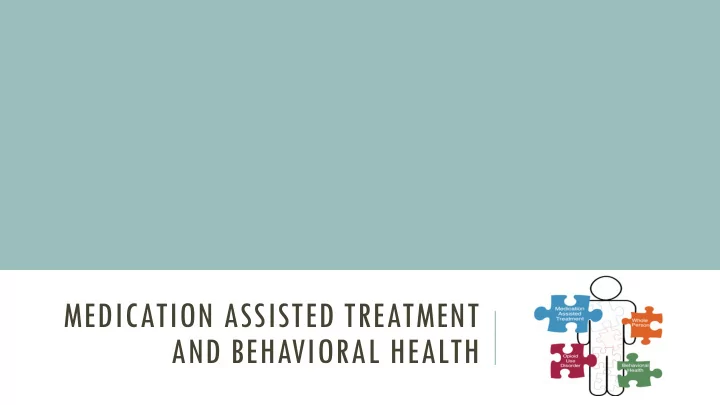

MEDICATION ASSISTED TREATMENT AND BEHAVIORAL HEALTH
SAMHSA TREATMENT IMPROVEMENT PROTOCOL (TIP) 63 “The law requires buprenorphine prescribers to be able to refer patients taking OUD medication to counseling and ancillary services. Buprenorphine prescribers may meet this requirement by keeping a list of referrals or by providing counseling themselves. The law doesn’t require naltrexone prescribers to refer patients to additional services. However, FDA labels for both medications recommend counseling as part of treatment”.
PSYCHOLOGICAL BENEFITS OF MAT IN RECOVERY Normalizes brain chemistry. Blocks euphoric effects of opioids or other substances. Relieves psychological cravings and normalizes body functions without the negative effects of the abused drug. MAT helps alleviate the withdrawal symptoms which allows the client to then begin working in counseling on mental health or other issues that may have either contributed to their use or were created as a result of their use.
BENEFITS OF BEHAVIORAL HEALTH TREATMENT IN MAT Modify underlying behaviors that may lead patient to misuse or relapse. Help patient improve problem-solving and interpersonal skills. Build relapse prevention planning. Replace use with constructive, rewarding activities. Encourage patients to adhere to their prescribed medications. Treat existing psychiatric disorders. Connect patient to support systems or provide family therapy. Connect patients to other community based services such as AA or NA.
DSM 5 CRITERIA FOR SUD 1. Tolerance 2. Withdrawal 3. Significant amount of time spent in using activities 4. Loss of control over use 5. Unsuccessful efforts to cut back or quit 6. Cravings 7. Continued use despite negative impact on major role obligations 8. Continued use despite having recurrent social or interpersonal problems related to use 9. Important social/occupational/recreational activities given up due to use 10. Continued use in hazardous situations 11. Continued use despite negative impact on physical or mental health condition
DSM 5 CRITERIA FOR SUD
DSM 5 CRITERIA FOR SUD
ASAM CIRTERIA
ASSIGNING LEVEL OF CARE Level of care is determined based on: DSM criteria ASAM risk rating worksheet Patient need Clinical judgement
LEVEL OF CARE Level 1 (Mild) Group setting or 1:1 with a counselor 1-1.5 hours weekly Level 2 (Moderate-Severe) Intensive Outpatient Treatment (IOP) Group setting 9 hours weekly, 3 days a week for 3 hour sessions Curriculum based, evidenced based Level 3 (Severe) Inpatient
EFFECTIVE THERAPIES IN THE TREATMENT OF OPIOID USE DISORDER Motivational interviewing Helps resolve ambivalent feelings and insecurities to find the internal motivation they need to change their behavior. Strengthen the patients own motivation and commitment to change. Help the client move towards their own goals by drawing out and building on their readiness to change.
EFFECTIVE THERAPIES IN THE TREATMENT OF OPIOID USE DISORDER Cognitive Behavioral Therapy (CBT). Individual therapy Highly effective with co-occurring disorders Identifies destructive thought patterns. Encourages patients to question and examine their reoccurring thoughts in order to phase out those that are negative, unhealthy and self-defeating.
EFFECTIVE THERAPIES IN THE TREATMENT OF OPIOID USE DISORDER Moral Reconation Therapy (MRT) Effective with criminal population or treatment resistant clients Group and individual therapy Seeks to change how substance abusers make decisions and judgments by increasing moral reasoning, enhancing self-image, and promoting the growth of a positive identity.
OTHER THERAPIES AND TREATMENTS THAT CAN BE EFFECTIVE IN THE TREATMENT OF CO-OCCURRING DISORDERS Dialectical Behavioral therapy (DBT) Eye Movement Desensitization and Reprocessing Therapy (EMDR) Family Therapy Case Management Peer Support
SAMHSA TIP 63 Principles of Effective Treatment In its Principles of Drug Addiction Treatment, the National Institute on Drug Abuse lists 13 principles of effective treatment (p. 2). 59 Two principles that pertain to counseling are: “No single treatment is effective for everyone. Treatment varies depending on the type of drug and the characteristics of the patients. Matching treatment settings, interventions, and services to an individual’s particular problems and needs is critical to his or her ultimate success in returning to productive functioning in the family, workplace, and society.” “Effective treatment attends to multiple needs of the individual, not just his or her drug abuse. To be effective, treatment must address the individual’s drug abuse and any associated medical, psychological, social, vocational, and legal problems. It is also important that treatment be appropriate to the individual’s age, gender, ethnicity, and culture.”
Recommend
More recommend